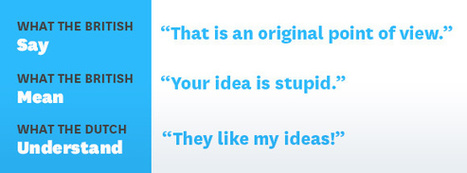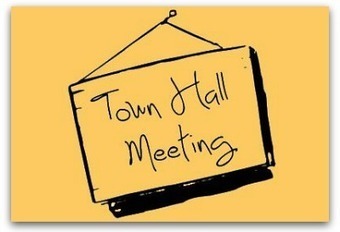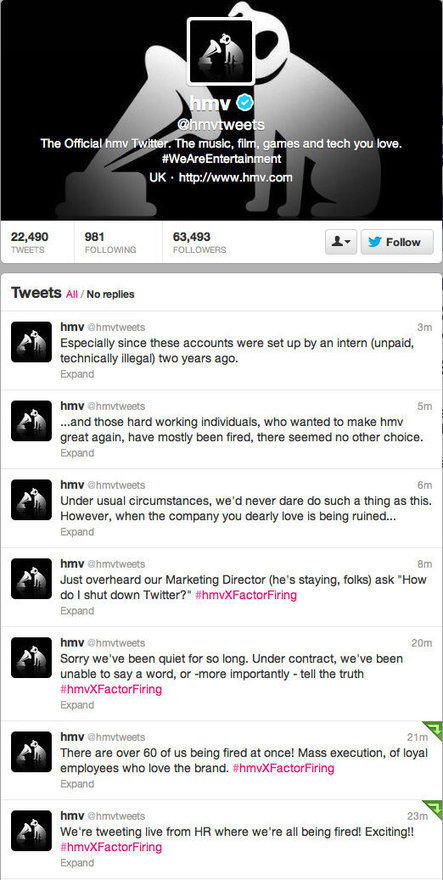 Your new post is loading...
 Your new post is loading...
...Managers in different parts of the world are conditioned to give feedback in drastically different ways. The Chinese manager learns never to criticize a colleague openly or in front of others, while the Dutch manager learns always to be honest and to give the message straight. Americans are trained to wrap positive messages around negative ones, while the French are trained to criticize passionately and provide positive feedback sparingly.
One way to begin gauging how a culture handles negative feedback is by listening to the types of words people use. More direct cultures tend to use what linguists call upgraders, words preceding or following negative feedback that make it feel stronger, such as absolutely, totally, or strongly: “This is absolutely inappropriate,” or “This is totally unprofessional.”
By contrast, more indirect cultures use more downgraders, words that soften the criticism, such askind of, sort of, a little, a bit, maybe, and slightly. Another type of downgrader is a deliberate understatement, such as “We are not quite there yet” when you really mean “This is nowhere close to complete.” The British are masters at it. The “Anglo-Dutch Translation Guide”, which has been circulating in various versions on the Internet, illustrates the miscommunication that can result....
Though it may seem counterintuitive, giving employees time to play around on their smartphones every day could actually benefit businesses, new research suggests.
Even though it might seem like smartphones would hamper workplace productivity — thanks to their ability to make telephone calls, surf the Internet and play games — they might not be the costly distraction companies think they are, according to a study by two members of theSociety for Industrial and Organizational Psychology.
...They found a positive relationship between using smartphones to take short breaks for things like texting friends and how employees felt at the end of the workday....
So often we can feel like we are drowning in a sea of monotony. Find a cause that makes you want to wake up every morning and change the world.
... Having a role is good. Doing well feels great. Being acknowledged for a job well done feels even better. That sensation we get when we do something right and you know that everyone around is thinking, “dang, you go!” instills a sense of pride that no one can take away.
That feeling can be hard to come by. So often we can feel like we are drowning in a sea of monotony. So many of us start work thinking that this is going to be the right place to work and you work there and it turns out your boss is a jerk or your coworkers suck or it’s just not what you wanted. Quitting usually seems like the best option at that point. That is okay!..
How corporate speak makes a tough decision look even worse in this internal memo to remaining employees...
"At Rogers Media, we are committed to delivering world-class content to consumers. It’s a new era in the media industry, one that is challenging yet full of opportunity. These changes are driven by the rapid pace of technological advancement, the increase in global choices for consumers, and an ever-changing advertising market.
Today we made changes to our business that will allow us to continue to make investments in our priority brands and strategic growth initiatives, and better position us for the future while helping us effectively manage our costs...."
Turns out it has little to do with whether you’re an extrovert or an introvert, open-plan office spaces just aren’t good for getting work done.
Offices that lump employees together in large spaces, called open-plan offices, have detrimental effects on workplace productivity despite previous claims that such configurations promote communication and boost morale, a new study by Jungsoo Kim and Richard de Dear of the University of Sydney Faculty of Architecture has found. Based on a survey of more than 42,000 United States office workers, the researchers found that workers who had private offices were far more satisfied than those in an open-plan office....
Here are 5 benefits of using a mobile app for your internal crisis communications - and which industries and types of organizations would best benefit.
Intranets are a great tool for large organizations that have offices all around the country and the world, but what about when you have workers on the ground? Workers on the ground don’t necessarily have a computer in front of them at all times, but what they definitely do have is a mobile phone. Creating an app designed specifically for your internal (crisis) communications will allow you to:- Access and reach each and every member of your team, no matter where they are at any given time – and all at once...
What started as a phenomenon on a more personal level is now extending its reach to work and offices.
Learn why P&G adopting digital is a battle that's going nowhere... ...When I wrote about their layoffs last year, I cautioned P&G (because they were obviously reading my blog article) that: - Digital media is not free - Not all advertising is inherently bad - Not all digital advertising is inherently effective. Apparently, the words of warning did not resonate. This week, Business Insider reported that CEO Bob McDonald actually ended up cutting 6,250 jobs as part of his cost-savings program -- so my 1,600 figure last year fell short of reality -- and that part of that program included "using more social media like Facebook and Google, which deliver 'free' ad impressions."...
Can you spot the differences between these two statements? 1. "You're required to create three videos a month." 2. "If you make the effort to create three videos each month, you'll get your own video equipment and software to use for free. Not only that, we'll recognize you as a leader in the company." It's like night and day, isn't it? According to Paolo Tosolini, director of emerging media at Run Studios, all it takes is a little incentive—a little bit of making video production into a game—to get employees excited about bringing their expertise to their company's video messaging. It's a good way to get employees to watch important videos, as well.
In a digital and social age, pipes are less important. People are the channel. You don't own or rent them. You can't control them. You can only serve and support them. This new world is disorienting because pipes and people work very differently as channels. Pipes flow out; people flow in. Content is pushed out through pipes, but pulled in through people. This reversal is shifting the balance of power. Individuals have access to information, tools, and resources once reserved for institutions. Externally, this means a shift in the relationship between customers and brands. Internally, this means breaking down the silos that once divided functions and departments. What used to be a hierarchy with the company at the top is now a network with the customer at the center. For marketers, this of course changes everything. As part of an awards program that one of us (Cara) created and the other (Mark) helped judge, we had the opportunity to see how hundreds of top marketers in Silicon Valley are engaging customers and growing revenue in this new era. The two most important principles that emerged are that customers make the best brand advocates, and entire organizations make for the best marketing teams....
United Technologies is at the top of its game but recently announced big layoffs. Is this the new normal?... ... This growth was accomplished, however, without expanding its workforce much at all, and now UT believes it can continue to grow as it wants to while actually shrinking its employee base. It's planning to lay off 3000 workers this year, after shedding 4000 last year. Now, is this really anything new? After all, output has been going up and employment simultaneously going down in manufacturing around the world for several years now, and UTC is a big manufacturer. But two things strike me as potentially novel here. First, the company does a lot more than just make things in factories. As its website says, "United Technologies... is a diversified company that provides a broad range of high-technology products and services to the global aerospace and building systems industries." Servicing elevators, security systems, and so on, in other words, is a big part of what UTC does, and services have historically been very labor-intensive. That could be changing....
Case Study: Good Corporate Communications in a ‘Difficult Situation’ Earlier this month at PyCon 2013 — a big tech industry conference for developers — a female attendee tweeted a picture of two male attendees, publicly shaming them for making inappropriate sexist jokes. This tweet led to at least two people losing their jobs. One of them was the woman herself, who worked for SendGrid as a “developer evangelist”, and the incident has sparked heated debate about sexism in tech and attacks on all sides. But stepping away from the commentary regarding her intentions or actions, we can learn some valuable PR lessons from the actions of a company facing fire due to the actions of an individual employee. As the title of the CEO’s public statement implies, SendGrid did an excellent job of handling a “difficult situation” by taking a stance and communicating it quickly to stakeholders. SendGrid correctly decided that the incident required a corporate response....
The hyper-local news website network issued an internal memo on Friday touting good news to come. On Monday, heads rolled and some offices were shuttered. Imagine you're sitting at your desk at work on a Friday afternoon. You're shocked to receive an email stating that the company's CEO is resigning, but the chairman sends a reassuring follow-up email stating that some positive retooling is coming. Then, on Monday, you and a lot of the other people in your office are laid off—with no severance pay. It sounds outlandish, but that's exactly what happened to employees at Daily Voice, a network of hyper-local news websites in the Northeastern United States. According to Gawker, employees were told Monday the company would shutter 11 bureaus in Massachusetts. Many of the most experienced employees in its Connecticut and New York offices received layoff notices. Those sites will continue running with smaller staffs....
|
Social Media , Collaborative Technology , Connected Customers, Digital Leaders - all are changing the way we work and play.
Here are 20 examples of organisations who are using the digital economy to reshape the way business is done.
...In January 2014, the San Francisco Chronicle, one of the country’s oldest remaining metropolitan newspapers, opened a technology incubator. The declining but still important media company is investing in a rigorous digital boot camp for reporters to learnhow to use social and mobile media to boost views, amplify sharing, and increase views and engagement. The Chronicle has no choice. Circulation plummeted 50% between 2009 and 2012. Revenue too is just not what it used to be. More importantly, readership is no longer the same as it was. Gripping headlines, animated GIFs, infographics, punchier copy, and innovative content marketing techniques are changing how people read and also how and what they share.
This move sends a loud and alarming message to executives everywhere, “adapt or die.” And to do that, businesses need to embrace not only new technology but also empower employees to engage with customers and stakeholders in the places where their attention is focused in ways that are culturally relevant. Employees must add value in every touch point and at every moment of truth throughout the customer lifecycle if they hope stay competitive...
Batman has a utility belt: a set of useful gadgets he can rely on during his never-ending fight against crime....
Yammer is a lot like Batman’s utility belt.
In the same way that the utility belt offers a solution for every scenario Batman might encounter in the fight against crime, Yammer offers — either out of the box or through an add-on app — a solution for most every social business use case. Newsfeed? Check. Document collaboration and conversation? Check. Integration with external applications? Check. Mobile apps for all leading platforms? Check. Badging? Check (try the Badgeville app). Et cetera, et cetera.
Every once in a while both Batman and Yammer run into scenarios that aren’t so common. Sometimes (and more often than you might think) Batman might need to fight a shark. And sometimes Yammer makes a lot of sense as a way to engage external users — in a fashion that goes well beyond the traditional “extranet” scenario...,
As marketers, we’re always searching for a formula for how to be successful — but there’s no formula for this:
While watching Wistia’s recent dance video promoting a feedback survey, I realized that it wasn’t the production, the camera, or the lighting that made the video so compelling, or explained why I watched and shared it with friends. It was the personality of the company’s people shining through.
Wistia offers an incredibly comprehensive guide on how to make incredible marketing videos for your company, but there’s one vital ingredient to successful marketing that can’t be taught in an instructional video.Today, it’s company culture that creates marketing messages that spread. It’s that secret sauce that’s impossible to replicate....
If you're a nonprofit executive and you're reading this, I have a message for you: Stop scaring your employees. Stop treating them like sheep, trembling at the thought of taking even the slightest risk.
Sheep never take risks because they’re afraid of the clippers. That approach might work just fine for sheep, but won’t work for a nonprofit that wants to get ahead.Risk is the source of great ideas, shorter shortcuts, and happier employees. But somehow, you’ve set up an environment where people are afraid that they’ll get judged or even fired if they take a risk....
CEOs often are in the dark as to whether their people truly understand their vision. It's a dangerous place to be, and it's a difficult situation to diagnose and address....
When you step on stage at the company meeting, are those smiling, nodding heads really absorbing the new company vision and goals for the year? According to a recent Harvard Business Review article, “When CEOs Talk Strategy, Is Anyone Listening?” only a fraction of our workforce is really clued in.
The article cites recent research which says that even in high-performing companies with “clearly articulated public strategies,” only 29% of their employees can correctly identify their company’s strategy out of six choices.This is not the strategy du jour. This is your company’s core, single most important strategic statement – a definition of why the business exists and why it’s worth investing in for the future. That means 70% (7 out of 10) of all employees (yes, even yours) are unknowingly misaligned with your company’s strategic direction....
Most businesses need employee participation to create quality content. Two methods to leverage the content marketing potential of employees.... In order for most businesses to create a lot of high quality content, employee participation is necessary. I’ve said many times, no marketing department is big enough to produce all the content it needs. Additionally, consider that in most businesses the marketing team is not comprised of domain experts. Here’s what Forrester Research says on this topic: “Today’s B2B buyer will find three pieces of content about a vendor for every one piece that marketing can publish or sales can deliver. They are finding this content in an ever-expanding number and variety of channels.” The way I see it, there are two primary methods to harness employee involvement in a social business. One involves a carrot and one involves a stick....
I have evaluated dozens of CEO/executive town halls. As idealists, when we plan these events we envision a turn-of-the-century town hall during which passionate employees engage in vigorous debate with organizational leaders.... Most forums have too much content and a lengthy presentation with too much detail. In addition to substance, our leaders tend to be too positive and rarely negative, and employees don't think they are getting the truth. This sort of comment is heard: "That is not the real strategy; the real strategy happens behind closed doors." The good news is that employees tell me they really do want to know and understand strategy and what is impacting the business. They just don't believe that happens in leader forums. Senior executives tell me they want to know the best way to share their direction and strategy for the organization. Employees tell me they want the truth. They want unscripted answers and to participate in a discussion about the competing demands placed on the business....
Prescient Digital Media's 2013 study found the implementation of social intranet tools on the rise at most businesses, but satisfaction is quite low. Why aren't employees and executives happier? The firm's 2013 Social Intranet Study found that 76 percent of the companies surveyed use instant messaging, at least in some limited way. About 75 percent use blogs. Around two-thirds have wikis, discussion forums, and user comments. It's fair to say social tools are being used widely. However, only 19 percent of organizations rated their social intranet tools as good or very good. Even fewer executives, 17 percent, like them. Toby Ward, president of Prescient Digital Media, says the tools are easy to come by, but demonstrating their value is considerably tougher....
According to a survey of large organizations around the world, businesses are ready and willing to support their external social media budgets with spending on internal efforts.... Large companies aren’t just spending on social media in a way that touches customers directly. They’re also investing in developing social media capabilities within their own organizations. According to a study of worldwide companies with over 1,000 employees conducted by the Altimeter Group, companies dedicated between 20% and 37% of their total social media development spending to “internal social media” in 2012....
As the discussion around social media evolves to social business, the social employee is becoming more and more important to the future of marketing... ... The current challenge facing businesses today is this: you can’t communicate externally unless you communicate internally. Sounds simple, right? But, unfortunately, business culture over the last 30 years (or even longer) has tended to prize cutthroat competitiveness and information hoarding as workers attempted to climb over each other in order to get to the top. So how do we change this? How do we build cultures where transparent internal communication and information sharing is prized above all else? Real culture change must come from all levels of the organization, but it must be driven and modeled by the executives in the C-Suite. Successful organizations in the new business climate have dynamic, engaging social executives who know exactly how to fuel and empower their employees and show them what it means to be social. Executives must understand that “do as I say, not as I do” won’t cut it among today’s workers. If they expect their employees to adopt new social habits, they must lead the way and model those habits first....
When the rumblings of an organizational crisis begin, a skilled communicator understands how critical their actions are in ensuring employees make it through the process as engaged and informed as possible. Failing to provide enough knowledge or context to your workforce could have damaging results for your company. Take the case of HMV. The entertainment retailer had a social media meltdown recently when staff took over the company's Twitter account to express anger at being fired [click on the image below to see the tweets in full]. Employees “live blogged” their own sacking on the site and HMV moved to delete the posts from the @hmvtweets account, which broadcast the news to its 60,000+ followers.... To keep employees engaged through the crisis process and protect both internal and external reputation, there are key actions you can take....
|



 Your new post is loading...
Your new post is loading...




![10 Shocking Statistics About Employee Engagement [infographic] | Public Relations & Social Marketing Insight | Scoop.it](https://img.scoop.it/alpzFdNyh6qsujxJDb0vBjl72eJkfbmt4t8yenImKBVvK0kTmF0xjctABnaLJIm9)




























Very interesting and, IMHO, has value even for people write for culturally homogeneous audiences.